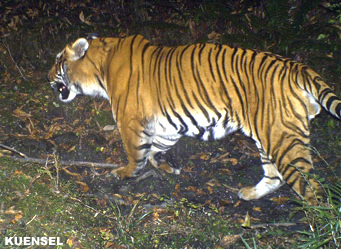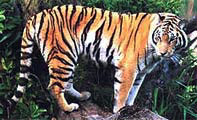| Bhutan's
Nature - Animals |
 |
Bhutan Nature Animals |
|
 |
Bhutan Nature Animals |
 |
Bhutan Information |
|
|
 |
| Tigers
in Bhutan |
 |
 |
| Camera traps reveal the presence of Tiger in Trongsa |
|
The Bengal tigers (Panthera tigris tigris) is the most numerous sub-species, numbering 3,000-4,500 individuals. India is home to the largest total population of the sub-species, which is also found in Bangladesh, Bhutan, Myanmar, China, and Nepal.
The Bengal tiger inhabits deciduous, temperate, and evergreen forests, grasslands, and mangroves, and is classified as Endangered.
|
|
| Fund
to protect Tiger population |
 |
 |
| With
an estimated population between 115 - 150 of which 60 to 80 (see: Tiger population 2015) are breeding
adults, the kingdom's tigers form the core of one of the two largest tiger
populations in the sub continent. The (potential) tiger habitat in the
kingdom is about 10,714 sq. kilometres with the big cat distributed from
the broadleaf to the coniferous forests according to the nature conservation
division. |
|
"The tiger is an indicative species being on top of the food
chain and its presence means that the natural environment is healthy,"
the Nature Conservation Department said.
The
tigers of Bhutan belong to the sub species, Panthera Tigris Tigris, popularly
known as the royal bengal tiger.
When
it comes to conservation of the endangered tiger, Bhutan is better off
than most other countries in the region. A trust fund to save tigers is
expected to be created from July 2002.
top
| Farmers
don't like tigers |
 |
But
to many farmers the tiger is better known for attacking and killing livestock
every now and then. The list includes cattle, yaks, mules, horses, sheep
and goats. Records collected by the Nature Conservation Department NCD
between 1999 and 2001 reveal that 218 heads of livestock were killed by
tigers.
Even though the tiger is listed in schedule I of the Nature Conservation
Act as a totally protected species, frustrated farmers have retaliated,
by trapping the tiger and poisoning the carcass of the killed livestock.
Records from the field offices show that at least two tigers are killed
this way every year. That worries the NCD. NCD officials say the conflict
between the tiger and the farmer is primarily because the tiger habitat
and grazing areas overlap. By law people own grazing rights and any feasible
area can be used as pasture land. "But when a cattle is killed, the cost
is borne by the cattle owner," NCD said. "Now we want to ensure that
the tiger population is maintained and at the same time farmers are compensated."
NCD
hopes to achieve this through a Tiger Trust Fund (TFF) project which will
come through in July this year. The project's immediate objectives are
to compensate for livestock killed by tigers and to provide immediate relief
to farmers. This, it is hoped, will deter farmers from trying to poison
the big cat.
NDC
head Dr Sangay Wanghuck said that the project had two challenges. "The
first is to get proper verification that livestock was killed by a tiger
and not a leopard or some other animal. The second is ensure timely monetary
compensation for affected farmers." A part of the WWF funded tiger conservation
programme which started in 1995, WWF is contributing US $ 30,000 to the
project which will be managed by a board. NCD also plans to make the fund
sustainable by ploughing back from fines on poaching of tigers, interest
on capital and other sources. "NCD officials said they had to do something
to compensate farmers who were always losing not only to tigers but more
seriously to wild boars and monkeys that destroy farm crops," said a WWF
spokesperson.
top
| 'Vision
and strategies' for protected areas |
 |
Apart
from several endangered species of flora and fauna, 7,000 species of plants,
165 species of mammals and 700 species of birds can be found in the forests
of Bhutan which cover 72 percent of the country's area.
Two
years ago a 'biological corridor' was created to link the protected areas
to prevent the 'genetic erosion' of plants and animals. Conservation
of the natural environment has always been a priority of the royal government.
The new vision and strategy document, he said, will ensure a more focused
approach and also take into account emerging conservation issues in the
management of the protected areas. The document, among other things, will
set conservation goals, give direction and incorporate the changing role
of the nature conservation division. While lack of adequate communication
among various stakeholders, human wild life conflicts, poaching, inadequate
human and financial resources and forest fires have been identified as
major problems, the richness of biodiversity, strong political donor support,
potential for eco-tourism and research opportunities are outlined as opportunities.
Although a protected area system was established since the early 60's most
of the areas were confined to the northern and southern belts.
Apart
from several endangered species of flora and fauna, 7,000 species of plants,
165 species of mammals and 700 species of birds can be found in the forests
of Bhutan which cover 72 percent of the country's area.
| Contributed
by KUENSEL, Bhutan's National Newspaper |
 |
top
| Wildlife and People in Bhutan |
 |
| Information on Bhutan |
 |
| Links |
 |
 |
 |
External
links |
|
|






